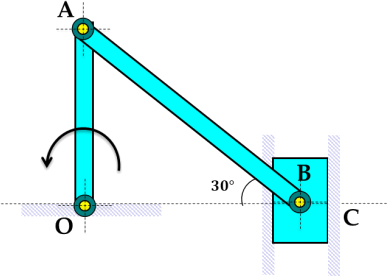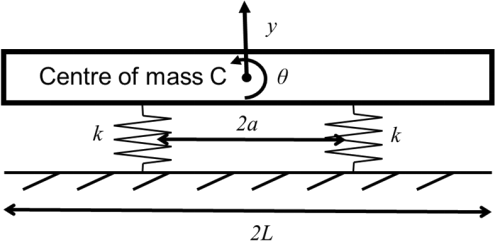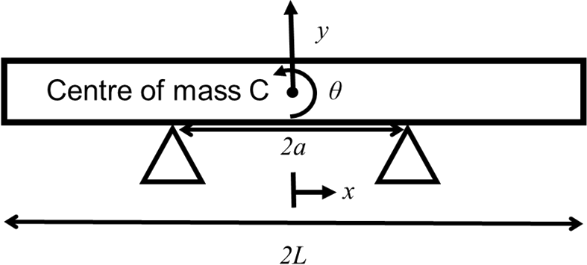JEIG2002W1 MECHANICS, MACHINES AND VIBRATION SEMESTER 1 EXAMINATIONS 2022-23
Hello, dear friend, you can consult us at any time if you have any questions, add WeChat: daixieit
JEIG2002W1
SEMESTER 1 EXAMINATIONS 2022-23
TITLE: MECHANICS, MACHINES AND VIBRATION
Q.1.
(i) Using Grubler’s formula, calculate the mobility of the mechanism shown in Figure 1.a. Pins A and B are connected to the frame. [5 marks]

Figure 1.a.
(1) In Figure 1.b., the crank OA rotates at a constant angular velocity of 12 rad/s in the anti-clockwise direction. The crank is 0.3 m and the coupler AB is 0.6 m. The slider at B moves only in the vertical direction.

Figure 1.b. (Not to Scale)
For the position shown in Figure 1.b., draw the velocity and acceleration diagrams and determine the following:
a) Velocity of all the joints [9 marks]
b) Angular velocity of the coupler [2 marks]
c) Centripetal accelerations of the coupler [9 marks]
d) Acceleration of the slider [2 marks]
(iii) For the position when the angle between the coupler and the horizontal line has reduced to 15 degrees, for the mechanism shown in Figure 1.b., locate all the instantaneous centres of velocity. [6 marks]
TOTAL [33 MARKS]
Q.2.
A sensitive piece of equipment mass m is installed on an isolation system inside a rigid casing, which is itself securely attached to the floor of workshop. The isolation comprises two identical elastic supports, each of stiffness k1, placed above and below the mass and a viscous damper c attached below the mass, as illustrated in Figure 2.1. The workshop floor is subject to ground vibration, which can be considered as a vertical displacement of the floor and the rigid casing and is equal to x0(t). Let x(t) be the dynamic displacement of the mass as shown.

Figure 2.1.: Isolated equipment inside a rigid case (black case shown bolted to a workshop floor).
(i) Draw the Free Body Diagrams for the vertical dynamic forces acting on the mass m and on the floor from the static equilibrium position of the mass, i.e., you do not need to include its weight but expressions for the forces should be given in terms of the parameters presented for the two springs and viscous damper. [6 marks]
(ii) Hence write down the equation of motion for the mass and, in terms of the isolation parameters, derive from first principles an expression for the critical damping for free vibration for such an isolation configuration. [6 marks]
[Hint: You can check your equation of motion using Lagrange’s equations, but no additional credit will be given].
(iii) For harmonic motion of the floor ![]() , obtain an expression for the magnitude of the transmissibility TR, i.e. letting
, obtain an expression for the magnitude of the transmissibility TR, i.e. letting ![]() the transmissibility TR is
the transmissibility TR is ![]() . [4 marks]
. [4 marks]
(iv) On log-log scales, sketch the variation of the magnitude of the transmissibility TR versus angular frequency ![]() . Clearly indicate the important features on the sketch, i.e. low and high frequency behaviour, the resonance and isolation regions. [4 marks]
. Clearly indicate the important features on the sketch, i.e. low and high frequency behaviour, the resonance and isolation regions. [4 marks]
(v) For the actual installation the following parameter values are given: m = 10 kg, k1 = 5 kN/m and c = 60 Ns/m.
Estimate the factor by which the free vibration amplitude of the mass would reduce 2 s after any floor disturbance has stopped. [5 marks]
(vi) Determine the frequency range over which the mass would be isolated, i.e., the magnitude of TR is less than unity. [3 marks]
(vii) Describe briefly in words the advantage(s) or disadvantages of either changing the value of the stiffness of the elastic supports or the value of the viscous damping constant. [5 marks]
[TOTAL 33 marks]
Q.3.
(i) A uniform rigid shelf is supported on symmetrically placed identical elastic supports as shown in Figure 3.1. The shelf is of length 2L, mass m and moment of inertia about its centre Im. The supports have stiffness k and are positioned equally spaced apart a distance 2a about the centre of mass C.

Figure 3.1. A shelf on its elastic supports
Determine the two lowest natural frequencies, where the shelf is considered to be rigid and undergoing small rotation , about C, and displacement y, of C, from the horizontal equilibrium position.
a) Derive the equations of motions, using Lagrange’s equations, in terms of the rotation and the displacement. Clearly state any assumptions made and show the relevant diagrams or relationships used in the derivation. [10 marks]
b) Obtain algebraic expressions for the two undamped natural frequencies and describe these modes in words. [11 marks]
(ii) At high frequencies the shelf is effectively pinned by the supports, as shown in Figure 3.2. Rayleigh’s method is to be applied to estimate the fundamental natural frequency of the shelf in bending where the displacement y can be described by ![]() , where the function
, where the function ![]() is to be chosen.
is to be chosen.

Figure 3.2. A higher frequency model for the shelf vibration. N.B. The spatial domain for the shelf is given by ![]() .
.
(a) Determine which of the following two shape functions ![]() or
or ![]() satisfy all of the sufficient conditions and is suitable to use? [4 marks]
satisfy all of the sufficient conditions and is suitable to use? [4 marks]
(b) Obtain an expression for the fundamental natural frequency of the shelf in bending under these approximations using your functions of choice from part (i) and using constant beam properties for the bending stiffness and mass per unit length, EI and ![]() , respectively. [5 marks]
, respectively. [5 marks]
(c) Using the result from part (ii)(b), or otherwise, what might you infer or believe would happen on the fundamental natural frequency if the supports are either closer or further apart? Hint: consider setting a = L and a = 0. [3 marks]
[TOTAL 33 marks]
2023-07-26